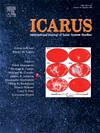冰结块的除气作用 II
IF 3
2区 物理与天体物理
Q2 ASTRONOMY & ASTROPHYSICS
引用次数: 0
摘要
这项工作的目的是分析彗核排气速率方程适用性的局限性。我介绍了使用由半径达几厘米的团块组成的大型样本进行实验的结果。在这方面,目前的工作是 Kossacki 等人(2023 年)关于毫米级团块混合物除气的论文的继续。团聚体半径与团聚体中最小颗粒半径之比以前约为 10,现在约为 100。实验过程中测得的样品质量变化与根据样品结构和记录温度计算得出的结果进行了比较。我们考虑了两种不同的数学模型。其中一个需要了解孔隙率,但不需要了解材料的造粒(Kossacki 2021),而第二个则需要了解最小颗粒和团聚体的半径,以及团聚体之间孔隙中的蒸汽压力(Kossacki 等人,2023)。研究发现(1) 两种模型都能再现实验结果;(2) 孔隙中的气体压力归一化为相平衡压力时,与温度的关系密切,而与团聚体大小的关系较弱。基于上述结果,我建议使用不包含孔隙中蒸汽压力的方程。本文章由计算机程序翻译,如有差异,请以英文原文为准。
Outgassing of ice agglomerates II
The aim of the work is to analyze limitations of the applicability of equations for the rate of outgassing of the nuclei of comets. I presented the results of experiments performed using large samples composed of agglomerates of radii up to few centimeters. In this respect the present work is the continuation of the paper Kossacki et al. (2023) about the outgassing of mixtures of millimeter sized agglomerates. The ratio between the radii of agglomerates and the radii of smallest grains present in agglomerates was previously about 10 and now is about 100. The measured changes of masses of the samples during experiments were compared with the results of calculations based on the structures of the samples and the recorded temperatures. Considered were two different mathematical models. One requires knowledge of the porosity, but not of the granulation of material (Kossacki 2021), while the second assumes knowledge of the radii of the smallest grains and of the agglomerates, as well as of the vapor pressure in pores between agglomerates (Kossacki et al. 2023). It was found that: (1) both models can reproduce the results of experiments and (2) the gas pressure in pores normalized to the pressure of phase equilibrium exhibits strong dependence on the temperature and weak dependence on the sizes of agglomerates. Based on the presented results I recommend to use equations which do not include the vapor pressure in pores.
求助全文
通过发布文献求助,成功后即可免费获取论文全文。
去求助
来源期刊

Icarus
地学天文-天文与天体物理
CiteScore
6.30
自引率
18.80%
发文量
356
审稿时长
2-4 weeks
期刊介绍:
Icarus is devoted to the publication of original contributions in the field of Solar System studies. Manuscripts reporting the results of new research - observational, experimental, or theoretical - concerning the astronomy, geology, meteorology, physics, chemistry, biology, and other scientific aspects of our Solar System or extrasolar systems are welcome. The journal generally does not publish papers devoted exclusively to the Sun, the Earth, celestial mechanics, meteoritics, or astrophysics. Icarus does not publish papers that provide "improved" versions of Bode''s law, or other numerical relations, without a sound physical basis. Icarus does not publish meeting announcements or general notices. Reviews, historical papers, and manuscripts describing spacecraft instrumentation may be considered, but only with prior approval of the editor. An entire issue of the journal is occasionally devoted to a single subject, usually arising from a conference on the same topic. The language of publication is English. American or British usage is accepted, but not a mixture of these.
 求助内容:
求助内容: 应助结果提醒方式:
应助结果提醒方式:


